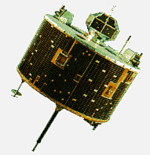Hiten

Hiten spacecraft
|
|
| Names | Muses-A (before launch) |
|---|---|
| Operator | ISAS |
| COSPAR ID | 1990-007A |
| SATCAT no. | 20448 |
| Website | ISAS Hiten page |
| Mission duration | 3 years, 2 months and 17 days |
| Spacecraft properties | |
| Launch mass | 197.4 kg (435 lb) |
| Start of mission | |
| Launch date | 11:46:ss, January 24, 1990--> |
| Rocket | Mu-3S-II (no. 5) |
| Launch site | Uchinoura Space Center |
| End of mission | |
| Decay date | 18:03:25.7, April 10, 1993 |
| Flyby of Moon | |
| Closest approach | 20:04:09, March 18, 1990 |
| Distance | 16,472.4 km (10,235.5 mi) |
| Moon orbiter | |
| Orbital insertion | 13:33, February 15, 1993 |
| Orbit parameters | |
| Periselene | 6.52 Lunar radii |
| Aposelene | 29.42 Lunar radii |
| Inclination | 34.7° |
| Moon impactor | |
| Impact date | 18:03:25.7, April 10, 1993 |
| Impact site | 34°18′S 55°36′E / 34.3°S 55.6°E |
The Hiten Spacecraft (ひてん, Japanese pronunciation: [hiteɴ]), given the English name Celestial Maiden and known before launch as MUSES-A (Mu Space Engineering Spacecraft A), part of the MUSES Program, was built by the Institute of Space and Astronautical Science of Japan and launched on January 24, 1990. It was Japan's first lunar probe, the first robotic lunar probe since the Soviet Union's Luna 24 in 1976, and the first lunar probe launched by a country other than the Soviet Union or the United States.
Hiten was to have been placed into a highly elliptical Earth orbit with an apogee of 476,000 km, which would swing past the Moon. However, the injection took place with a delta-v deficit of 50 m/s, resulting in an apogee of only 290,000 km. The deficiency was corrected and the probe continued on its mission.
On the first lunar swing-by, Hiten released a small orbiter, Hagoromo (はごろも, named after the feather mantle of Hiten), into lunar orbit. The transmitter on Hagoromo failed, but its orbit was visually confirmed from Earth. After the eighth swing-by, Hiten successfully demonstrated the aerobraking technique on March 19, 1991. This was the first aerobraking maneuver by a deep space probe. After the ninth lunar swing-by and second aero-braking maneuver on March 30, 1991, the primary mission of the probe was concluded.
Edward Belbruno and James Miller of the Jet Propulsion Laboratory heard of the failure of the Hagoromo orbiter and helped to salvage the mission by developing a so-called ballistic capture trajectory that would enable the main Hiten probe to itself enter lunar orbit. Belbruno had been working on numerically modelling low-energy trajectories, and heard of the probe's problems. He developed a trajectory for the main probe to enter lunar orbit and on June 21, 1990, sent an unsolicited proposal to the Japanese space agency. They responded favorably, and later implemented a version of the proposal.
...
Wikipedia
